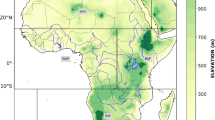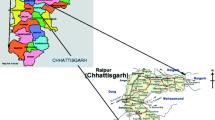Abstract
Drought Indexes (DIs) are commonly used for assessing the effect of drought such as the duration and severity. In this study, long term precipitation records (monthly recorded for 44 years) in three stations (Boutilimit (station 1), Nouakchott (station 2), and Rosso (station 3)) are employed to investigate the drought characteristics in Trarza region in Mauritania. Six DI methods, namely normal Standardized Precipitation Index (normal-SPI), log normal Standardized Precipitation Index (log-SPI), Standardized Precipitation Index using Gamma distribution (Gamma-SPI), Percent of Normal (PN), the China-Z index (CZI), and Deciles are used for this purpose. The DI methods are based on 1-, 3-, 6-, and 12 month time periods. The results showed that DIs produce almost the same results for the Trarza region. The droughts are detected in the seventies and eighties more than the 1990s. Twelve drought years might be experienced in station 2 and six in stations 1 and 3 in every 44 years, according to reoccurrence probability of the gamma-SPI and log-SPI results. Stations 1 and 3 might experience fewer drought years than station 2, which is located right on the coast. In station 1, which is located inland, when the annual rainfall is less than 123 mm, it is likely that severe drought would occur. This is 63 mm/year for station 2 and 205 mm/year for station 3 which is located in the south west on the Senegal River. DI results indicate that the CZI and the gamma-SPI methods make similar predictions and the log-SPI makes extreme drought predictions for the monthly period for all the stations. For longer periods (3-, 6-, and 12 month period), for all the stations, the log-SPI and the gamma-SPI produce similar results, making severe drought predictions while the normal-SPI and the CZI methods predict more wet and fewer drought cases. The log-SPI, the gamma-SPI, PN and Deciles were able to capture the historical extreme and severe droughts observed in early 1970s and early 1980s.
















Similar content being viewed by others
References
Abramowitz M, Stegun IA (1965) Handbook of math functions. NBS Appl Math Ser 50:487
Alley WM (1984) The Palmer drought severity index: limitations and assumptions. J Clim Appl Meteorol 23:1100–1109
Asikoglu OL, Ciftlik D (2015) Recent rainfall trends in the Aegean region of Turkey. J Hydrometeorol 16(4):1873–1885. doi:10.1175/JHM-D-15-0001.1
Barua S, Ng A, Perera B (2010) Comparative evaluation of drought indexes: case study on the yarra river catchment in Australia. J Water Resour Plan Manag 137:215–226
Cacciamani C, Morgillo A, Marchesi S. Pavan V (2007) Monitoring and forecasting drought on a regional scale: Emilia-Romagna region. Methods and tools for drought analysis and management. Springer
Edwards DC (1997) Characteristics of 20th century drought in the United States at multiple time scales. DTIC Document
Gąsiorek E, Musiał E (2015) Evaluation of the precision of standardized precipitation index (SPI) based on years 1954–1995 in ŁÓDŹ. J Ecol Eng 16:49–53
Gibbs Maher WJ (1915–1967) Rainfall deciles as drought indicators / by W. J. Gibbs and J. V. Maher., Melbourne : Bureau of Meteorology, 1967., Gibbs and Maher.
Guttman NB (1999) Accepting the standardized precipitation index: A calculation algorithm1. Wiley Online Library
Hayes M (2003) Drought indices. National Drought Mitigation Center. http://www.drought.unl.edu/whatis/indices.htm. Accessed 27 May 2003
Hayes MJ (2006) What is drought? Drought indices. National Drought Mitigation
Hayes MJ (2006) Drought indices, Wiley Online Library. Center. (Online).< http://drought.unl.edu/whatis/indices.htm
HAYES MJ, SVOBODA MD, WILHITE DA, VANYARKHO OV (1999) Monitoring the 1996 drought using the standardized precipitation index. Bull Am Meteorol Soc 80:429–438
Ju X, Yang X, Chen L-J, Wang Y (1997) Research on determination of station indexes and division of regional flood/drought grades in China. QJ Appl Meteorol 8:26–32
Keyantash J, Dracup JA (2002) The quantification of drought: an evaluation of drought indices. Bull Am Meteorol Soc 83:1167
Lloyd‐Hughes B, Saunders MA (2002) A drought climatology for Europe. Int J Climatol 22:1571–1592
Madsen H, Mikkelsen PS, Rosbjerg D, Harremoës P (1998) Estimation of regional intensity-duration-frequency curves for extreme precipitation. Water Sci Technol 37:29–36
Mckee TB, Doesken NJ Kleist J (1993) The relationship of drought frequency and duration to time scales. Proceedings of the 8th Conference on Applied Climatology, 1993. American Meteorological Society Boston, MA, USA, 179–183
MISHRA AK, SINGH VP (2010) A review of drought concepts. J Hydrol 391:202–216
MORID S, SMAKHTIN V, MOGHADDASI M (2006) Comparison of seven meteorological indices for drought monitoring in Iran. Int J Climatol 26:971–985
Palmer WC (1965) Meteorological drought. US Department of Commerce, Weather Bureau, Washington, DC
SONMEZ FK, KOMUSCU AU, ERKAN A, TURGUT E (2005) An analysis of spatial and temporal dimension of drought vulnerability in Turkey using the standardized precipitation index. Nat Hazards 35:243–264
Spinage C (2012) African ecology: benchmarks and historical perspectives, Springer Science & Business Media
Thom HCS (1966) Some methods of climatological analysis. WMO Technical Note Number 81. Secretariat of the World Meteorological Organization: Geneva, Switzerland, p 53
Todorovic P Woolhiser D (1976) Stochastic Structures of the Local Pattern of Precipitation. Stochastic Approaches to Water Resources, 2
Tsakiris G, Pangalou D, Vangelis H (2007) Regional drought assessment based on the reconnaissance drought index (RDI). Water Resour Manag 21:821–833
Wilhite DA (1996) A methodology for drought preparedness. Nat Hazards 13:229–252
Wilhite DA (2000) Drought as a natural hazard: concepts and definitions. In: Wilhite DA (ed) Drought: a global assessment. Routledge, London, pp 3–18
Wu H, Hayes MJ, Weiss A, Hu Q (2001) An evaluation of the Standardized Precipitation Index, the China‐Z Index and the statistical Z‐Score. Int J Climatol 21:745–758
Yuan W-P, Zhou G-S (2004). Comparision between standardized precipitation index and Z index in China. J Plant Ecol 28(4):523–529. (in Chinese)
Zeng N (2003) Drought in the Sahel. Science 302:999–1000
Author information
Authors and Affiliations
Corresponding author
Rights and permissions
About this article
Cite this article
Yacoub, E., Tayfur, G. Evaluation and Assessment of Meteorological Drought by Different Methods in Trarza Region, Mauritania. Water Resour Manage 31, 825–845 (2017). https://doi.org/10.1007/s11269-016-1510-8
Received:
Accepted:
Published:
Issue Date:
DOI: https://doi.org/10.1007/s11269-016-1510-8




